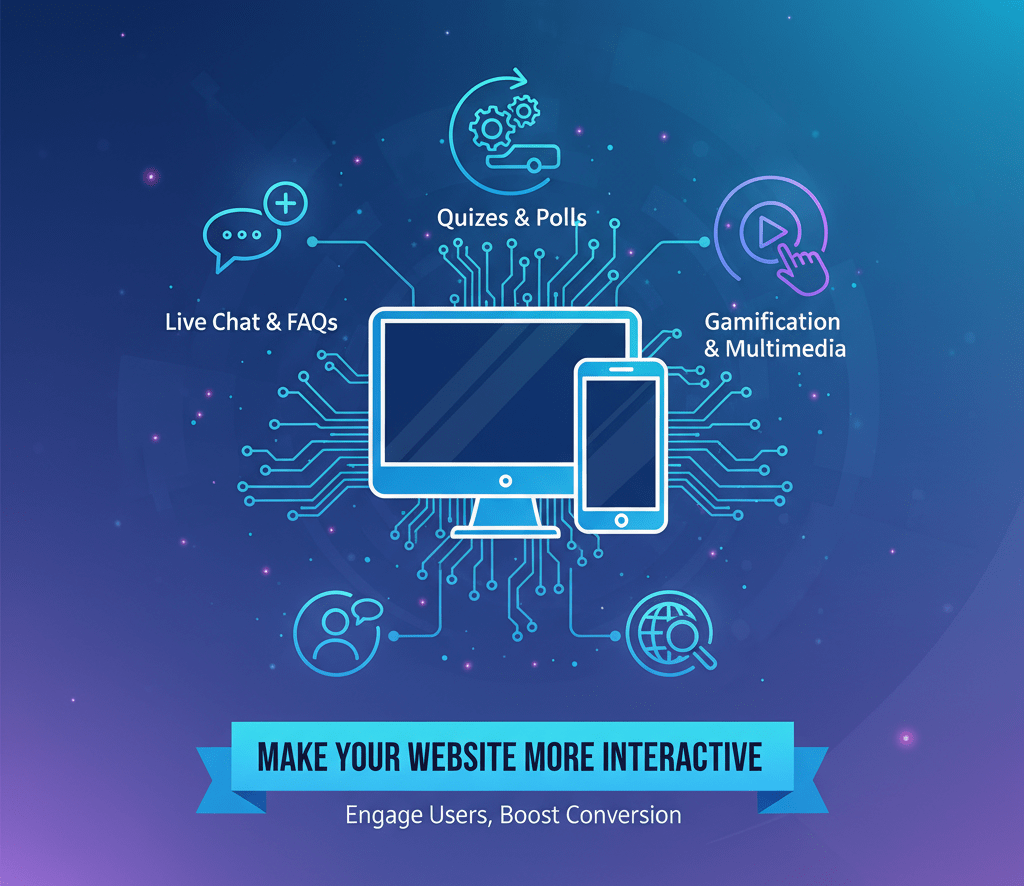“Discover how to make your website more interactive using a Voice AI Agent to automate FAQs, qualify leads, and book appointments, transforming your site into a 24/7 conversational powerhouse.”
Let’s be honest. How much of your website is just… sitting there?
You’ve spent thousands of dollars and countless hours on a beautiful design. You’ve written (or paid for) sharp, optimized copy. You’ve chosen the perfect images. And for what?
For most visitors, your website is a static, one-way street. It’s a digital brochure. They arrive, they scroll, they read, and then—more often than not—they leave. That “click” you hear in your analytics? That’s the sound of your back button, and another user bouncing.
The old model of the internet was about publishing. You put information out there, and people consumed it. But the new model—the one that actually builds businesses—is about interaction. It’s about engagement. It’s about a two-way conversation.
For years, we’ve tried to fake this interaction. We added comment sections (which are now mostly spam). We created “interactive content ideas” like quizzes and calculators (which are often clunky and require a developer). We installed basic chatbots that can only answer three pre-programmed questions before giving up and saying, “Please email support.”
This isn’t real engagement. It’s a low-effort attempt to stop the bleeding. If you’re serious about making your website more interactive, you need to stop thinking of your site as a page and start thinking of it as a place—a place where honest conversations happen.
This is where Voice AI Agents come in.
This isn’t just another chatbot. This is a fundamental shift in user interaction design. It’s the difference between giving someone a map (your current website) and giving them a personal guide (a voice AI agent). It’s the “wow” factor you’ve been missing. It’s the tool that will finally improve your website experience, keep people on your page, and turn passive visitors into active participants.
Here are seven concrete ways you can use a voice AI agent to transform your static site into an engaging, interactive powerhouse.

1. Ditch the Wall of Text: The Conversational FAQ
The Old Way:
The traditional FAQ page. We all know it. It’s a massive, intimidating wall of text. It’s a list of 50 questions and 50 answers, and the one question your user actually has is either buried at the bottom or not there at all.
What does a user do? They hit Ctrl+F (or Cmd+F) to search the page. If they’re on mobile, they just give up. It’s a terrible, high-friction experience. It practically screams, “We don’t really want to talk to you, so please try to find your own answer in this mess.” This is a primary driver of high bounce rates on support-related pages.
The New Way (with a Voice AI Agent):
Imagine a user lands on your pricing page. They’re curious, but confused about the difference between your “Pro” and “Enterprise” plans. Instead of scrolling, searching, or leaving, they see a friendly icon. They click it.
A pleasant, human-sounding voice pipes up: “Hi there! I see you’re looking at our plans. Do you have a quick question I can answer?”
The user, without typing a single word, simply asks, “What’s the main difference between Pro and Enterprise?”
Instantly, the AI agent responds: “Great question! The Pro plan is perfect for small teams and includes all our core features. The Enterprise plan adds single sign-on, a dedicated account manager, and priority 24/7 support. Are you curious about a specific feature, like API access?”
The “Wow” Factor and Business Impact:
This is a game-changer. The user gets an immediate, contextual, and personal answer. They didn’t have to hunt for it. They didn’t have to wait for a support ticket. They just asked.
For your business, this does several powerful things:
- Drastically Reduces Bounce Rate: You’ve instantly satisfied the user’s intent. They are no longer frustrated, so they stick around.
- Improves User Experience: The user feels heard and helped. This builds trust and positive brand association.
- Gathers Incredible Data: This is a fantastic customer feedback widget in disguise. You are no longer guessing what confuses your users. You are collecting a log of their exact questions, in their own words. This is a goldmine for improving your copy, your product, and your marketing.
You move from a static page that hopes to answer questions to an interactive agent that invites them to engage.
2. The Voice-Powered Site Navigator: Your Personal Tour Guide
The Old Way:
The navigation menu. Or worse, the “hamburger” menu on mobile. It’s a maze of dropdown menus, submenus, and footer links. “Where do they keep their case studies?” “Is ‘Blog’ under ‘Resources’ or ‘Company’?” “I just want to find their career page!”
This is especially painful for large e-commerce sites or complex B2B service companies. You have a deep, rich website, but 90% of your users only ever see the 10% that is easily accessible. Your “user interaction design” is actually creating friction.
The New Way (with a Voice AI Agent):
A user lands on your homepage. They have a specific goal. They click the agent icon.
Agent: “Welcome to our site! How can I help you navigate today? You can ask me to find a product, take you to a specific page, or show you our latest work.”
User: “Show me case studies for the healthcare industry.”
Agent: “You got it. Taking you to our healthcare case studies right now.”
Poof. The page loads. No clicking, no searching, no frustration.
Think bigger. What about users who don’t even know what they’re looking for?
User: “I’m looking for a gift for my husband.”
Agent: “A wonderful idea! Let me help. Can you tell me what his hobbies are? Is he into tech, outdoors, or fashion?”
User: “He loves tech.”
Agent: “Perfect. I’m filtering our ‘Gadgets & Tech’ category for you right now. Here are our top-rated gifts for tech lovers.”
The “Wow” Factor and Business Impact:
This is the Star Trek computer experience. It’s the ultimate in accessibility and efficiency. It makes the user feel powerful. They can command the website with their voice.
For your business, the benefits are clear:
- Increases Page Views & Session Duration: Users explore more of your site because it’s effortless. This is a massive boost to your user engagement metrics.
- Boosts Accessibility: This is a profound online engagement win for users with visual impairments, motor disabilities, or those who simply prefer voice commands.
- Modernizes Your Brand: It makes you look incredibly high-tech and user-focused. It differentiates you from every competitor still relying on clunky, 10-year-old menu designs.
Your website stops being a set of linked documents and becomes a responsive environment that reacts to your user’s voice.
3. The Interactive Product Recommender: A True Personal Shopper
The Old Way:
Static “Recommended Products” carousels. These are usually based on “what other people bought,” not what this specific user needs.
The other option is the filter sidebar. Price (low-high). Brand (A-Z). Color (15 checkboxes). This isn’t personalization; it’s a list of chores. The user has to do all the work, and they are often paralyzed by choice, leading to cart abandonment.
The New Way (with a Voice AI Agent):
An AI agent acts as a true consultant or personal shopper. It diagnoses the need before prescribing a solution.
Imagine a user on a B2B software site:
Agent: “Hi! It appears that you’re looking for a project management solution. Our platform is powerful, but it’s not a one-size-fits-all solution. To help, can I ask what your team size is?”
User: “We have about 30 people.”
Agent: “Great. And what’s the main thing you’re trying to track? Is it simple tasks, complex multi-stage projects, or client budgets?”
User: “Definitely complex projects with multiple dependencies.”
Agent: “Understood. Based on that, I’d strongly recommend our ‘Business’ plan. It includes the Gantt chart feature and advanced reporting you’ll need. I’d skip the ‘Starter’ plan, as it’s really just for basic task lists. Would you like to see a quick video demo of the Gantt feature?”
The “Wow” Factor and Business Impact:
The agent didn’t just find a product; it qualified the user and guided them to the right solution. It built confidence. It prevented them from buying the wrong plan and churning out a month later.
- Skyrocketing Conversion Rates: You are walking the user directly to the checkout button for the right product. This is website personalization at its finest.
- Higher Average Order Value: The agent can intelligently upsell and cross-sell. “Since you’re buying that camera, our most popular add-ons are the high-speed memory card and the extra battery pack. They are bundled together for a 10% discount. Should I add that?”
- Reduces Choice Paralysis: You cut through the noise and give the user 1-2 perfect options instead of 50 confusing ones.
This turns your e-commerce or B2B site from a simple catalog into a guided, consultative sales experience, 24/7.
4. The Conversational Lead Qualifier: No More Boring Forms
The Old Way:
The “Contact Us” form. It’s the digital equivalent of a brick wall. First Name, Last Name, Email, Phone, Company Name, Company Size, Budget, Message.
It’s an interrogation. It’s cold, impersonal, and demands a great deal from the user before offering any value in return. It’s no wonder that abandonment rates are astronomically high. We treat our most valuable prospects—people trying to give us money—like they’re filling out a tax return.
The New Way (with a Voice AI Agent):
You create a conversational landing page. A user clicks “Get a Quote” or “Talk to Sales.”
Agent: “Awesome! We’d love to chat. To ensure I connect you with the right expert, I just need to ask you a few quick questions. First, what’s your name?”
User: “My name is Sarah.”
Agent: “Great to meet you, Sarah! And what’s the best email to reach you at?”
User: “[email protected]”
Agent: “Perfect. And last question, just so my team is prepared: what’s the main challenge you’re hoping we can help you solve?”
User: “Our current lead generation is too low, and our website bounce rate is killing us.”
Agent: “That’s exactly what we specialize in. Thank you, Sarah. I’ve just sent all this information to our lead specialist, Alex, who will be in touch with you shortly. In the meantime, would you like to book a time directly on Alex’s calendar?”
The “Wow” Factor and Business Impact:
This is, without a doubt, one of the most powerful lead generation tools you can deploy. The psychology is entirely different.
- It’s a Conversation, Not a Form: Asking for one piece of information at a time is low-friction and feels natural. It uses the “foot-in-the-door” principle. Once they answer the first easy question, they’re likely to answer the rest.
- Massively Increases Lead Capture: You will capture more leads, period. The drop-off rate will be a fraction of your static forms.
- Delivers Pre-Qualified, High-Intent Leads: Your sales team doesn’t just get a form submission. They get a transcript. They know the user’s name, needs, and pain points in their own words. They can start the sales call with, “Hi Sarah, I read you’re struggling with a high bounce rate. Let’s talk about that.” The first call is 10x more effective.
You’ve transformed the most mundane part of your website into one of its most engaging and interactive elements.
5. The 24/7 Automated Appointment Scheduler
The Old Way:
This is the follow-up to the lead form. The user submits. They get an email that says, “Thanks, we’ll be in touch.” Then, 24 hours later, a salesperson emails them: “Hi, thanks for your interest. Are you free to chat next Tuesday?”
The user, who was a hot, high-intent lead 24 hours ago, is now in a meeting, busy, or has already found a competitor. This “phone tag” or “email tag” friction kills deals every single day.
Even embedded calendars like Calendly, while helpful, are still static. The user must click, select a date, check their calendar, find a time, and re-enter their info. It’s another set of tasks.
The New Way (with a Voice AI Agent):
Let’s rewind to our last example. The agent has just qualified the lead.
Agent: “…In the meantime, would you like to book a time directly on Alex’s calendar?”
User: “Yes, that would be great.”
Agent: “Perfect. I have Alex’s live calendar right here. Does some time this Thursday, October 24th, work for you?”
User: “Hmm, I’m busy. What about Friday morning?”
Agent: “Sure. On Friday, October 25th, Alex has availability at 9:30 AM or 11:00 AM Eastern. Which one works better?”
User: “11:00 AM.”
Agent: “Booked. I’ve just sent the calendar invite to you and Alex at [email protected]. We’ll talk to you then!”
The “Wow” Factor and Business Impact:
The entire process, from “I’m interested” to “Meeting on the calendar,” took less than 30 seconds. This is a zero-friction conversion.
- Closes the Loop Instantly: You capture the user’s intent at its absolute peak. You don’t give them a second to get distracted or look at a competitor.
- Saves Hundreds of Admin Hours: Your sales and support teams stop playing scheduler. They just show up to a calendar full of pre-qualified, pre-booked appointments.
- Improves Show-Up Rates: Because the booking was so immediate and conversational, it feels like a firm, personal commitment, not just another form submission that can be ignored.
This is a direct, measurable impact on your sales pipeline. It’s not just a “nice-to-have”; it’s a machine for generating revenue.
6. The Voice-Based Survey: Feedback That Feels Human
The Old Way:
The annoying, full-screen pop-up survey. “Please rate your experience on a scale of 1-10!” Or the 20-question email survey that promises a “chance to win a $50 gift card” that nobody ever fills out.
This data is low-quality. A “7” from one user means something completely different than a “7” from another. You get the what (the score), but you never get the why. And you’re annoying your users in the process.
The New Way (with a Voice AI Agent):
The AI agent can be configured to trigger after a successful event (like a purchase, a download, or a successful FAQ answer).
It appears non-intrusively.
Agent: “Hey, I’m so glad I could help you with that refund question! Before you go, would you mind answering two quick voice questions about your experience today? It really helps us improve.”
User: “Okay, sure.”
Agent: “Great. First, on a scale of 1 to 5, with five being super easy, how easy was it to find the answer you were looking for?”
User: “I’ll say a 4.”
Agent: “Thanks! And for my last question, what’s one thing we could have done to make that a 5 for you?”
User: (speaking naturally) “Well, I had to look for the ‘support’ button for a minute. It’s kind of hidden in the footer. Maybe move it to the top menu?”
Agent: “That’s brilliant feedback. I’ve passed it along to our design team. Thanks so much for your help!”
The “Wow” Factor and Business Impact:
You’ve just received a piece of gold. You got the quantitative score (4/5), but more importantly, you got the qualitative insight—the “why”—in the user’s own voice.
- High-Quality, Qualitative Data: People will say things they would never bother to type. A voice response is fast, easy, and feels like talking to someone directly. This is the ultimate customer feedback widget.
- Discover Actionable Insights: You’re not getting vague “NPS scores.” You’re getting specific, actionable to-do items, like “move the support button.” You can address real problems and enhance your user interaction design based on genuine feedback.
- Builds Goodwill: By asking for an opinion in a respectful, non-intrusive way, you make the user feel valued. They feel like they’ve contributed, rather than being harvested for data.
This is how you build a website that genuinely listens to its users and continually improves every day.
7. The Brand Persona Storyteller: Bring Your “About Us” Page to Life
The Old Way:
The “About Us” page. It’s almost always the most boring page on any website. It’s a 500-word block of corporate-speak about “Our Mission,” “Our Values,” and “Our Commitment to Synergy.”
Nobody reads it. Nobody connects with it. It’s a completely wasted opportunity to build an emotional connection with your audience.
The New Way (with a Voice AI Agent):
You turn your “About Us” page into an interactive story. This is where the AI’s personality shines. You’re not just providing info; you’re introducing a character—your brand.
A user lands on the page.
Agent: (with a voice that matches your brand—e.g., energetic and fun, or calm and reassuring) “Welcome! This is one of our favorite pages. This is where we get to tell our story. You can read the text, of course, or you can just ask me. For instance, you can ask ‘Who are the founders?’ or ‘What’s the crazy story behind your company name?'”
User: “Haha, okay. What is the story behind your name?”
Agent: “I thought you’d never ask! It all started back in 2018 when our founder, Jane, was trying to… [tells a 30-second, engaging, well-scripted brand story].”
User: “That’s cool. What’s your company culture like?”
Agent: “Oh, it’s all about ‘curious collaboration.’ In fact, every Friday we have… [describes a unique company ritual].”
The “Wow” Factor and Business Impact:
You have just done what 99% of your competitors can’t: you’ve made your brand memorable.
- Builds Real Brand Affinity: Storytelling is the most powerful tool in marketing. When a user hears your story in a personality-driven voice, they form an emotional connection. They’re not just customers; they’re fans.
- Increases “Sticky” Engagement: This is a pure online engagement play. It boosts time-on-page and makes your brand feel human and approachable.
- Differentiates You from Everyone: Your competitors are all using the same stock photos and generic mission statements. You have a brand persona that your users can actually talk to. This is the pinnacle of website personalization.
Your brand is no longer just a logo and a color palette. It’s a voice, a personality, and a story that your audience can interact with.
How to Do All This Without Writing a Single Line of Code
You’ve just read seven powerful, high-impact strategies. Your mind is probably racing. You’re considering ways to make your website more interactive, lower your bounce rate, and create a site that truly engages your audience.
But you’re also probably thinking: “This sounds amazing… and impossibly expensive and complicated. I’m not a developer. I don’t have a $100,000 budget for an AI team.”
This is the best part. You don’t need to.
All seven of these interactive experiences—the conversational FAQ, the site navigator, the product recommender, the lead qualifier, the appointment scheduler, the voice survey, and the brand storyteller—can be built right now, by you.
You can do it all with Scalewise.ai.
Scalewise.ai is the free, no-code AI Agent Builder designed for busy marketers, designers, and business owners. It was created on the belief that this powerful technology should be accessible to everyone, not just mega-corporations.
- It’s No-Code: If you can type in a Google Doc, you can build a powerful voice AI agent. You simply write the conversations, set up the logic (e.g., “if user asks this, say that”), and train it on your website data.
- It’s Free to Start: You can build and launch your agent on your website for free.
- It’s Easy to Implement: You just copy and paste a straightforward line of code onto your site—it works with WordPress, Shopify, Webflow, Squarespace, or any other platform.
You don’t need to spend months in development. You can have a powerful, interactive voice AI agent engaging your customers in the next 10 minutes.
Stop letting your users just read your website. It’s time to let them talk to it.
Start building your free AI agent at Scalewise.ai today and add the interactive “wow” factor your website has always been missing.
Frequently Asked Questions (FAQs)
Q1: Will adding a voice AI agent slow down my website?
This is a ubiquitous and essential question. The answer is no. Modern, well-built platforms like Scalewise.ai are designed to be incredibly lightweight. The agent loads asynchronously (meaning it doesn’t block the rest of your content from loading) and is optimized for performance. It won’t impact your page speed scores or your users’ loading experience.
Q2: How is this really different from a regular text-based chatbot?
It’s a night-and-day difference.
- Voice: The “wow” factor of a human-sounding voice is immense. It builds an emotional connection that sterile text bubbles simply can’t. It’s also far more accessible.
- Intelligence: Most chatbots are simple “if-then” trees. They break easily. An actual AI agent is trained on your data. It can understand intent and context, not just keywords.
- Action: A chatbot’s primary goal is to deflect support tickets. A voice AI agent’s goal is to take action. It can book meetings, navigate the site, qualify leads, and close sales, all within the conversation.
Q3: Do I really need to be a developer to set this up? What does “no-code” actually mean?
“No-code” means precisely that. With a platform like Scalewise.ai, you do all the “building” in a simple, visual, drag-and-drop style interface. You’ll write the “scripts” for your agent just like you’d write an email. You can connect it to your Google Calendar with just a few clicks, without needing to write API integrations. The only “code” you will ever see is the single line you copy and paste into your website’s header or footer—a process that takes about 30 seconds.
Q4: Will a voice agent improve my website’s SEO?
This is a great question. It’s an indirect but compelling benefit. Google’s algorithm loves high engagement. When a voice AI agent enhances your site’s interactivity, it directly improves key user engagement metrics.
- It Slashes Your Bounce Rate: Users get answers instead of leaving.
- It increases Time-on-Page: Users are busy talking to your agent, navigating, and exploring.
Google sees these signals and concludes that your site is a high-quality, valuable resource, which can positively influence your rankings over time.
Q5: Can the AI agent speak multiple languages?
Yes. Modern voice AI can be configured to interact in dozens of languages. This is a massive win for website personalization and global accessibility. You can have your agent automatically detect the user’s browser language or offer a simple choice, allowing you to provide a fully native, interactive experience to your entire audience, regardless of their location.





